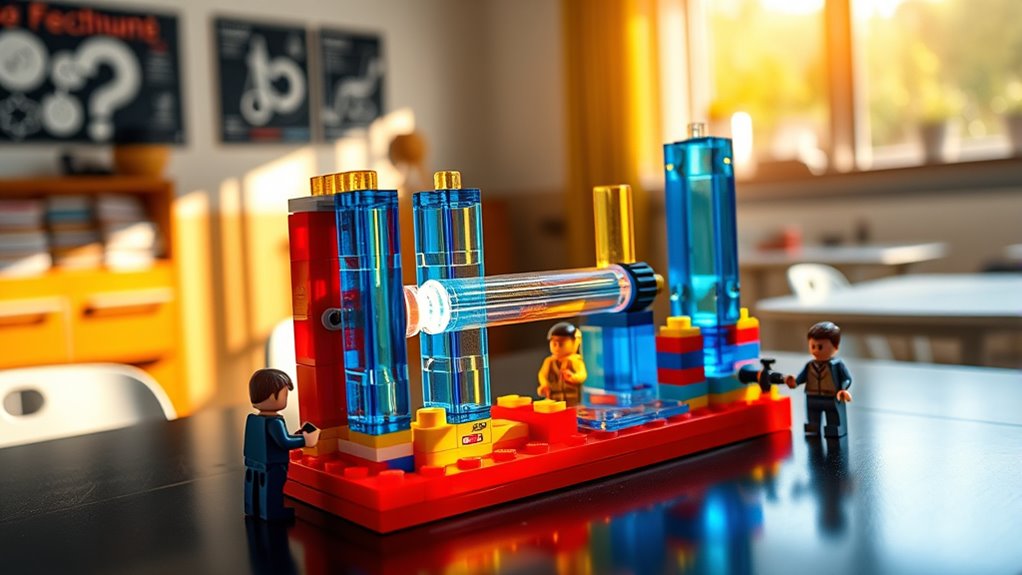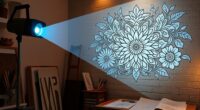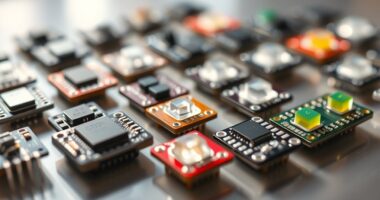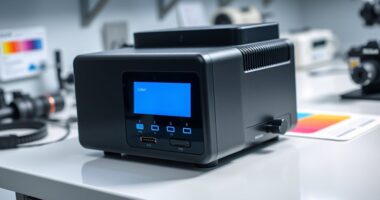If you’re looking for the best LEGO spectrometer projects for kids, I’ve found some fantastic options that combine hands-on building with science exploration. These kits promote learning in physics, astronomy, and engineering while encouraging creativity. They come with detailed instructions and various models like spectrometers, Newton’s Cradle, and hydraulic systems suitable for different ages and skill levels. Keep exploring to discover how these projects can spark your child’s curiosity and STEM skills.
Key Takeaways
- Highlights a variety of LEGO spectrometer projects suitable for children aged 6-12 to foster STEM learning.
- Details kit features including components, models, and easy-to-follow instructions for engaging experiments.
- Emphasizes safety, durability, and compatibility with digital devices for a seamless educational experience.
- Covers building complexity levels, from simple models for beginners to advanced spectrometers for older kids.
- Provides insights into science concepts like light spectra, energy, and cause-and-effect through hands-on activities.
Engino STEM Toys Physics Laws Engineering Kit for Kids

If you’re looking for an engaging STEM toy that makes physics concepts come alive for kids aged 9 and up, the Engino STEM Toys Physics Laws Engineering Kit is an excellent choice. I love how it offers hands-on exploration of essential physics principles like inertia, friction, and circular motion through six working models, including a rocket launcher and crash test rig. The kit combines building with learning, supported by detailed instructions and a 3D app for virtual reality experience. It’s praised for its educational value and fun, making science both accessible and exciting. Plus, it’s versatile enough for kids with different learning styles and abilities.
Best For: children aged 9 and above who are interested in hands-on STEM learning and exploring fundamental physics concepts through engaging models and digital tools.
Pros:
- Combines physical building with digital VR app for immersive learning experiences
- Includes detailed instructions with theory, facts, experiments, and quizzes to support diverse learning styles
- Recognized as one of the top STEM toys, fostering creativity, critical thinking, and science understanding
Cons:
- Instructions may be minimal or challenging to follow for some children, especially younger or less experienced builders
- Manuals and apps are primarily in English, which could pose language barriers for non-English speakers
- Some users have noted difficulty accessing additional manuals or resources due to login requirements
Engino STEM Building Toys and Engineering Kits for Kids
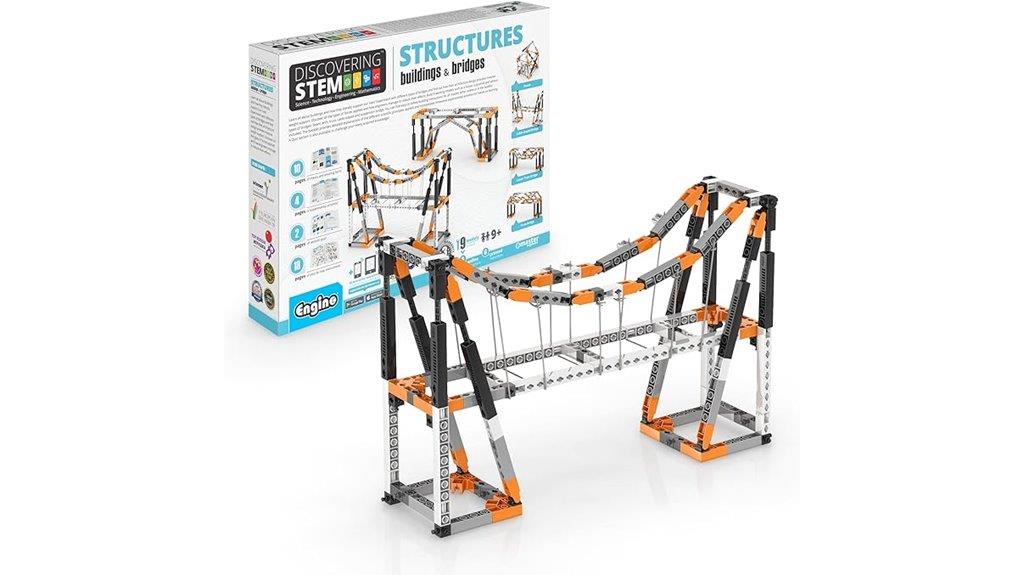
Engino STEM Building Toys and Engineering Kits are an excellent choice for young aspiring engineers and architects aged 9 and up who want to explore the fundamentals of construction and scientific principles. This set includes 9 models like houses, pyramids, and bridges, helping kids understand forces and weight support through hands-on building. Its award-winning components are made in Europe, making complex ideas accessible and engaging. The kit offers detailed theory pages, fun experiments, and an interactive 3D app for virtual building. Customers praise its quality, durability, and educational value, though some note assembly can be challenging without adult help. Overall, it’s a fantastic STEM learning tool.
Best For: young children aged 9 and up who are interested in exploring engineering, construction, and STEM concepts through hands-on building and interactive learning.
Pros:
- High-quality, durable components made in Europe that support complex projects
- Includes engaging educational materials such as theory pages, experiments, and an interactive 3D app
- Inspires creativity, critical thinking, and problem-solving in young learners
Cons:
- Assembly can be challenging and may require adult assistance, especially for complex models
- Instructions and app features sometimes lack detailed guidance for advanced projects
- Packaging or shipping issues have been reported by some users, though overall satisfaction remains high
Robotics Engineering Kit for Kids 8-12

The Robotics Engineering Kit for Kids aged 8-12 is an excellent choice for young aspiring engineers who want hands-on experience with electrical and mechanical design. It includes over 50 parts and offers more than 10 STEM projects that foster creativity, problem-solving, and critical thinking. Designed by scientists, this award-winning kit features electric motor kits, wood parts, and real hardware to make learning engaging and practical. It boosts STEM skills and inspires curiosity about robotics and engineering concepts. Perfect for ages 8 to 12, it makes a thoughtful gift that combines play with education, encouraging future innovators to explore their potential.
Best For: young children aged 8-12 who are interested in exploring electrical and mechanical engineering through hands-on STEM projects.
Pros:
- Encourages creativity, problem-solving, and critical thinking in a fun, educational way
- Includes over 50 parts and more than 10 engaging STEM projects suitable for beginners
- Recognized by reputable organizations, making it a trusted and award-winning educational toy
Cons:
- Requires 2 AA batteries, which are not included, potentially an extra purchase for some
- May be too simple for older children or those with advanced engineering experience
- Availability and prices may vary across different online platforms and stores
Engino STEM Toys Newtons Laws Inertia Building Kit for Kids
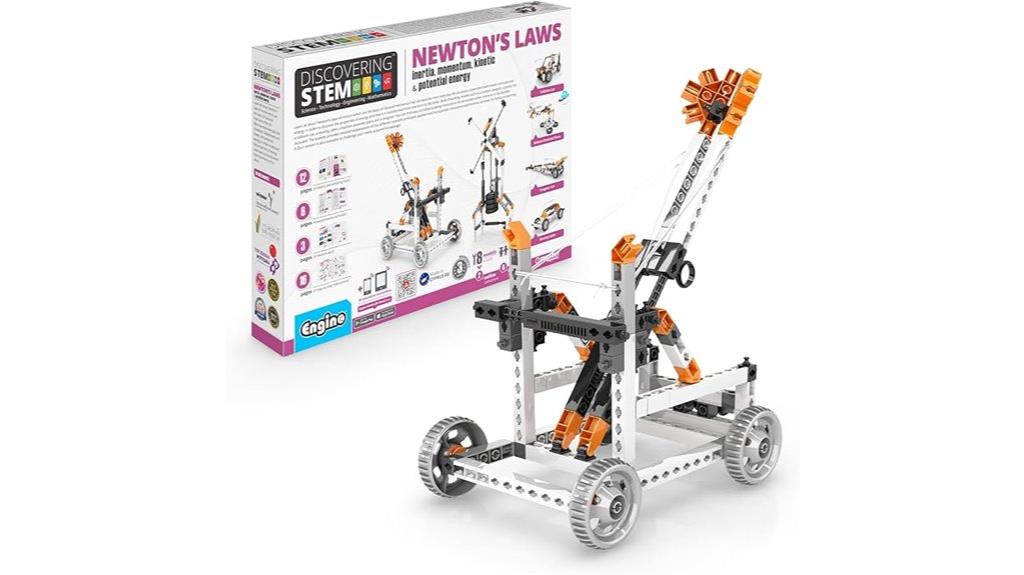
Designed for children aged 9 and up, the Newtons Laws Inertia Building Kit is perfect for young science enthusiasts enthusiastic to explore physics firsthand. This set includes 8 functional models like ballistic catapults, crash test cars, and balloon-powered planes, offering engaging hands-on experiments. Clear instructions, a 12-page theory guide, and a 3-page quiz help reinforce learning, while a free virtual reality app boosts interaction. Made in Europe, the high-quality parts encourage creative engineering and critical thinking. Although some parts may be delicate, the kit provides a fun, educational experience that helps kids understand inertia, energy, and motion through practical building and testing.
Best For: young science enthusiasts aged 9 and up who enjoy hands-on engineering projects and want to learn about physics concepts through building and experimentation.
Pros:
- Engaging, hands-on models that demonstrate Newton’s Laws and energy principles
- Includes comprehensive educational materials like theory guides and quizzes to reinforce learning
- High-quality components with interactive virtual reality app for enhanced engagement
Cons:
- Some parts may be delicate or flimsy, requiring careful handling and supervision
- Instructions are in English, which may pose challenges for non-English speakers
- Assembly can be time-consuming and may require adult assistance for younger children
Poraxy STEM Science Kits for Kids Ages 8-12
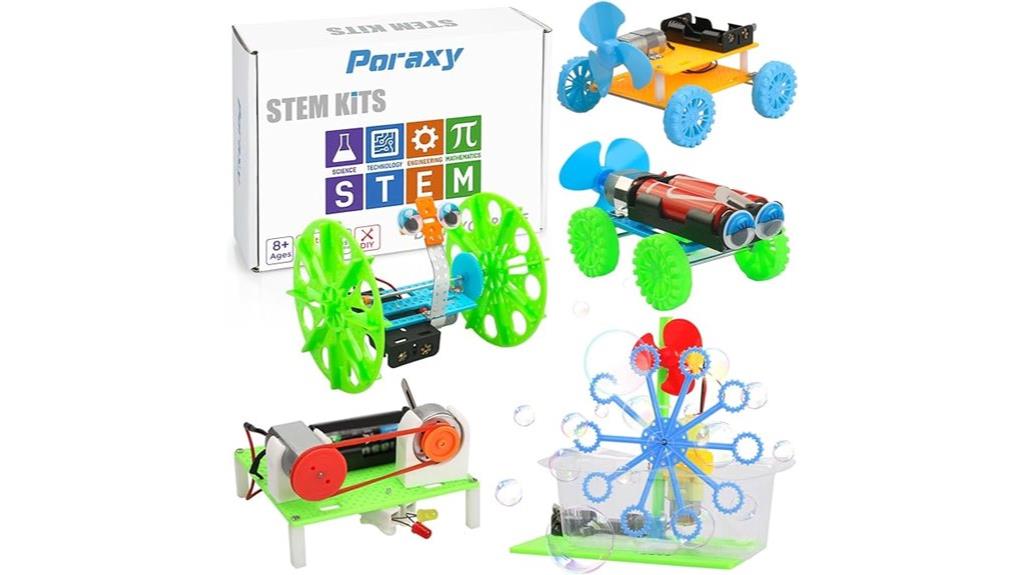
If you’re looking for a STEM kit that combines hands-on building with engaging science experiments, Poraxy STEM Science Kits for Kids Ages 8-12 are an excellent choice. This set includes five projects—cars, a robot, mini generator, and bubble machine—that boost skills in science, technology, engineering, and math. Designed for ages 6-14, it provides all parts needed for easy assembly, including a mini screwdriver and detailed instructions. Kids will develop practical skills, boost creativity, and improve problem-solving through experimentation. Perfect as a gift or educational activity, these kits make science fun and accessible, inspiring curiosity and a love for STEM.
Best For: children aged 8-12 who are interested in hands-on STEM activities that promote learning, creativity, and problem-solving through engaging building projects.
Pros:
- Includes five diverse projects that cover cars, robots, generators, and bubble machines, providing variety and comprehensive learning experiences
- Comes with all necessary parts, tools, and detailed instructions, making assembly easy and accessible for young learners
- Enhances practical skills, imagination, and critical thinking while fostering curiosity and interest in STEM fields
Cons:
- Price may vary across stores, and some customers might find it higher than similar kits
- Limited to certain age ranges (6-14), which might not suit older or younger children without additional guidance
- Some users might desire more advanced projects for older children or those with prior STEM experience
STEM Science Kits for Kids Ages 8-12
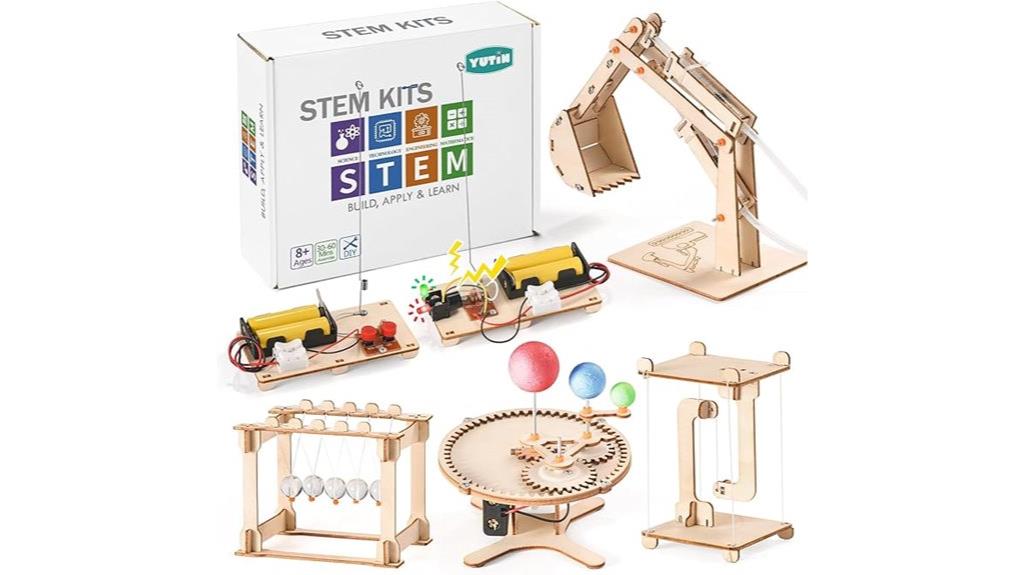
LEGO Spectrometer Projects for Kids stand out as an excellent STEM science kit for children aged 8 to 12 who are curious about science and engineering. These kits inspire hands-on learning with models like Newton’s Cradle, Hydraulic Excavators, and Sun-Earth-Moon systems, fostering problem-solving and creativity. Designed for ages 6-12, they combine fun with educational value, encouraging kids to explore physics, mechanics, and energy concepts. Made from safe, durable materials, they feature easy-to-follow instructions, making assembly accessible yet challenging enough to promote critical thinking. Perfect for birthdays, holidays, or back-to-school gifts, these kits ignite a passion for STEM in young learners.
Best For: children aged 6-12 who are interested in exploring science, engineering, and physics through hands-on, educational STEM kits.
Pros:
- Engages kids with fun, interactive models like Newton’s Cradle and Sun-Earth-Moon systems.
- Made from safe, durable materials with easy-to-follow instructions suitable for young learners.
- Enhances problem-solving, creativity, and critical thinking skills while providing educational entertainment.
Cons:
- Assembly may be challenging for children aged 6-8, requiring parental supervision.
- Slightly higher price point for comprehensive STEM kits compared to simpler toys.
- Limited to certain age ranges, so older children might find the content less challenging.
Thames & Kosmos Mechanical Engineering STEM Kit
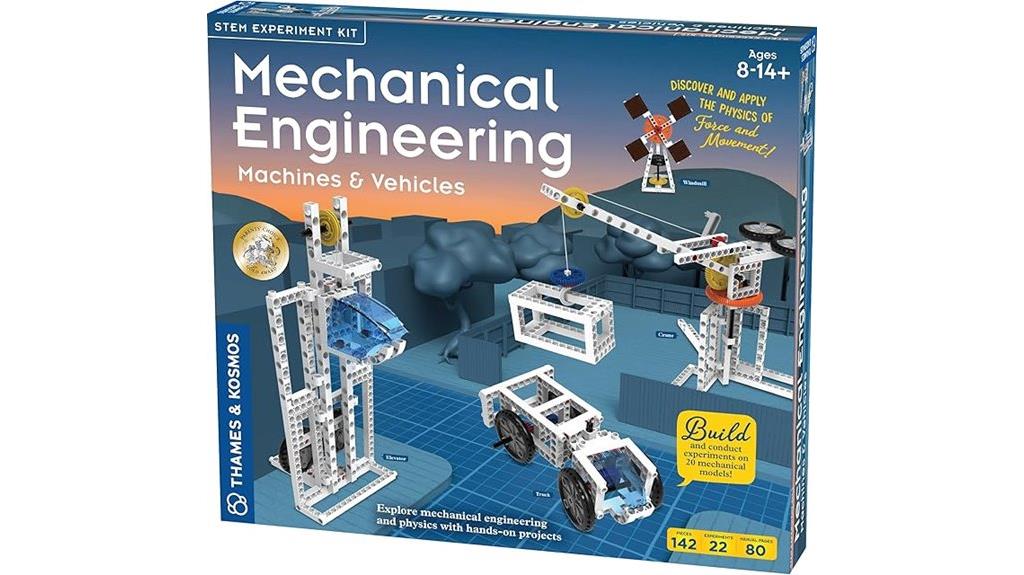
The Thames & Kosmos Mechanical Engineering STEM Kit is an excellent choice for young learners aged 8 to 14+ who want a hands-on introduction to engineering concepts. It offers 20 building projects and 22 experiments that explore forces, simple machines, gears, energy transfer, and physics related to the solar system. With 142 durable components, kids can build models like cranes, windmills, and ATVs, fostering creativity and problem-solving. The easy-to-follow 80-page manual explains science principles clearly, making complex ideas accessible. Overall, it’s a fun, educational kit that helps kids understand real-world engineering while encouraging imaginative exploration.
Best For: young learners aged 8-14+ interested in exploring engineering concepts through hands-on building and experiments.
Pros:
- Engaging and educational, covering a wide range of STEM topics with clear instructions.
- Durable, high-quality components suitable for reconfiguration and creative projects.
- Promotes problem-solving, critical thinking, and understanding of physics in a fun, interactive way.
Cons:
- Some parts may be difficult to fit together or share components across models, causing minor frustrations.
- Limited to the specific models and experiments provided, which may restrict ongoing customization.
- Younger children may require adult assistance to fully benefit from the manual and complex models.
STEM Robotics Science Kits for Kids 6-12

Designed for children aged 6 to 12, STEM robotics science kits offer an engaging way to introduce young learners to engineering, circuits, and coding. These kits include various robot models like rope-climbing, solar cars, and dancing crabs, with all necessary parts and tools. Assembly takes about 30-50 minutes, making them suitable for beginners, yet capable of independent completion by older kids. They foster hands-on learning for electronics, problem-solving, and creativity. Kids can craft, play, or use their robots as classroom decor. Perfect as gifts, these kits support STEM education while providing fun, educational activities that build essential skills in science and engineering.
Best For: young children aged 6 to 12 who are interested in exploring STEM concepts through hands-on robot building and science experiments.
Pros:
- Encourages creativity, problem-solving, and scientific exploration in kids.
- Includes diverse robot models and all necessary tools for easy assembly.
- Supports STEM education with engaging activities suitable for beginners and independent learners.
Cons:
- Assembly time may vary, and younger children might need supervision or assistance.
- Price and availability can fluctuate across different stores or online platforms.
- Some kits might require additional batteries or accessories not included in the package.
STEM Robotics Kit for Kids Age 8-12
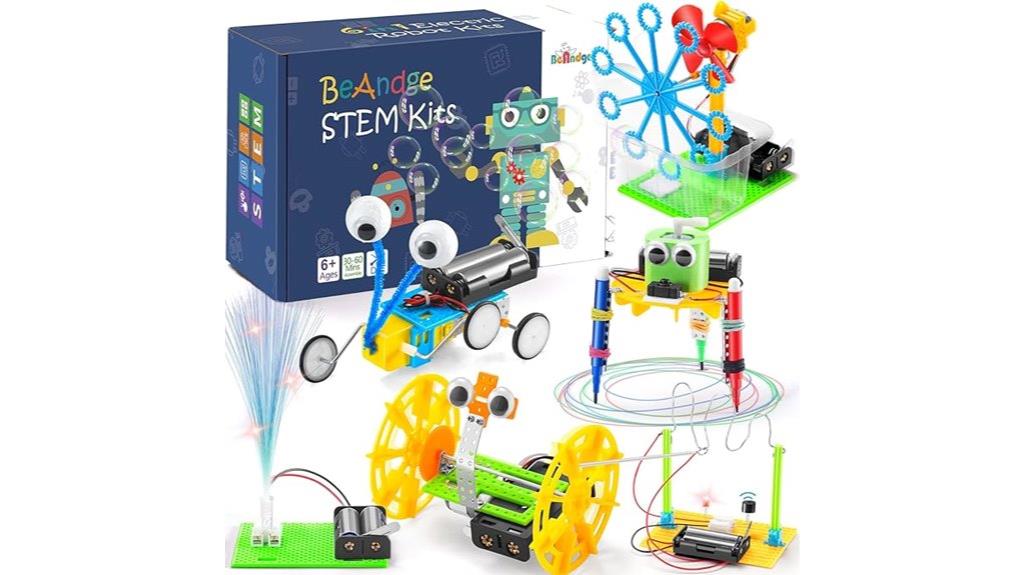
Looking for a STEM robotics kit that sparks creativity and learning in kids aged 8 to 12? This 6-in-1 kit offers a reptile robot, balance car, bubble machine, fiber lamp, and buzzer wire game, all made from safe, odorless materials. It’s perfect for hands-on experiments that introduce physics and engineering concepts, encouraging problem-solving and circuit understanding. The kit is easy to assemble with detailed instructions and a mini screwdriver, making it ideal for independent or family projects. It’s a thoughtful gift for budding inventors, fostering teamwork, curiosity, and early STEM skills in children aged 6-12.
Best For: parents, teachers, and children aged 6-12 seeking an engaging, educational STEM robotics kit that promotes creativity, problem-solving, and teamwork through hands-on building projects.
Pros:
- Promotes hands-on learning and sparks curiosity in physics and engineering concepts
- Easy to assemble with clear instructions and included tools, suitable for independent or collaborative projects
- Safe, odorless materials make it suitable for children and ideal as a gift for special occasions
Cons:
- Requires additional items like batteries and bubble solution not included in the kit
- Some components may be small, requiring supervision for younger children
- Limited to the specific set of projects included, which may need expansion for prolonged use
STEM Science Kits for Kids Age 8-12
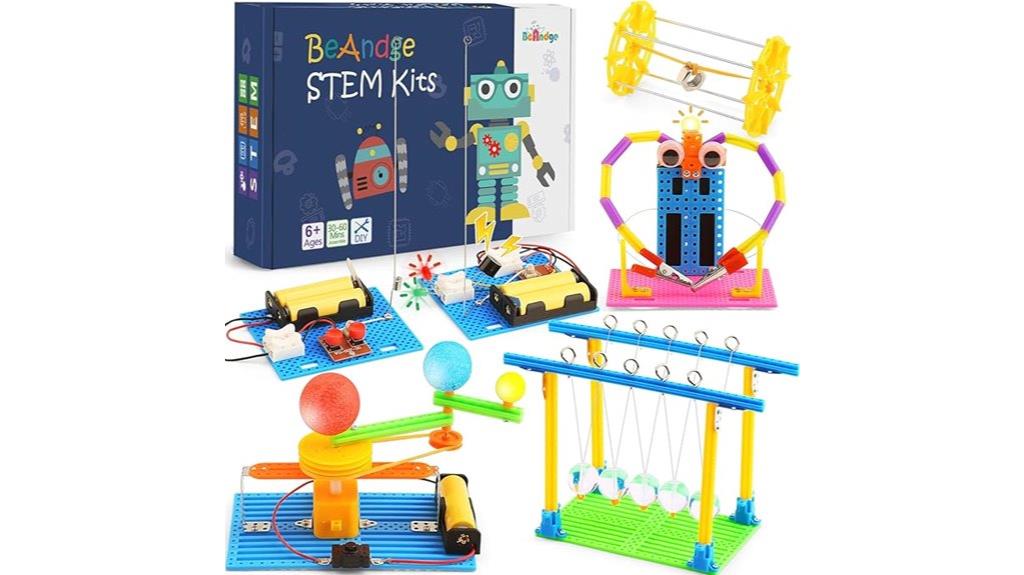
If you’re seeking a STEM science kit that challenges curious kids aged 8 to 12, the LEGO Spectrometer Projects stand out as an engaging option. These kits include five models covering physics, astronomy, and engineering, like a Telegraph, Newton’s Cradle, and Sun-Earth-Moon model. Designed to foster critical thinking and hands-on exploration, they come with easy-to-follow instructions, tools, and components suitable for independent or guided building. Rated highly for engagement and educational value, some projects may need adult help or clearer instructions. Overall, they make a fun, safe way to deepen scientific understanding and inspire creativity in young learners.
Best For: curious children aged 8 to 12 who enjoy hands-on STEM activities that challenge their critical thinking and promote scientific exploration.
Pros:
- Engaging and educational models that cover physics, astronomy, and engineering concepts
- Includes easy-to-follow instructions and tools suitable for independent building
- Highly rated for fun, learning, and fostering creativity in young learners
Cons:
- Some projects may require adult assistance due to complexity or unclear instructions
- Occasional missing parts or instruction errors can hinder the building process
- Might benefit from more age-appropriate guidance to enhance independent learning
LEGO Chain Reactions Science Kit
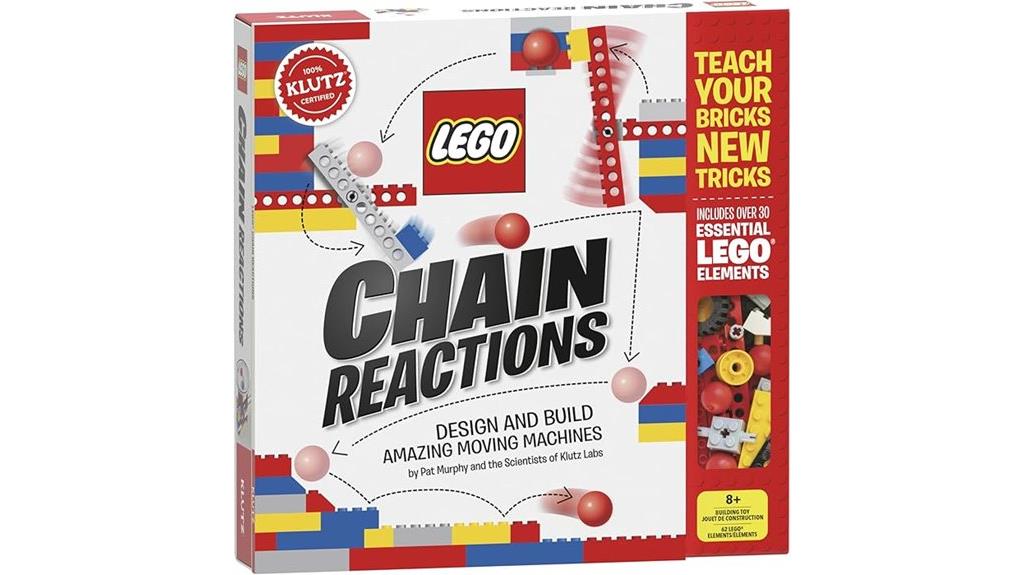
The LEGO Chain Reactions Science Kit is an excellent choice for kids aged 8 to 15 who love hands-on engineering and physics projects. It includes 33 specialized LEGO pieces, an 80-page instruction book, and various accessories like plastic balls, ramps, signs, and a funnel ramp, enabling kids to build 10 different moving machines. Designed to teach physics concepts through fun experimentation, the kit encourages creativity and problem-solving. Its clear instructions and versatile components make it accessible for beginners and engaging enough for more experienced builders. With its award-winning design, this kit truly makes learning about cause-and-effect and mechanical motion both educational and enjoyable.
Best For: children aged 8 to 15 who are interested in hands-on STEM activities, engineering, and physics experiments.
Pros:
- Includes comprehensive instructions and versatile components for creative building and learning.
- Encourages development of problem-solving, engineering, and cause-and-effect understanding.
- Award-winning design with high customer ratings indicating quality and educational value.
Cons:
- May require adult supervision or guidance for younger children to maximize learning.
- Some users might find the assembly instructions challenging without prior experience.
- Limited to a specific age range, which may not suit older or younger children interested in similar activities.
“Hydrobot Arm Kit”, Hydraulic Kit, STEM Building Toy for Kids 12+
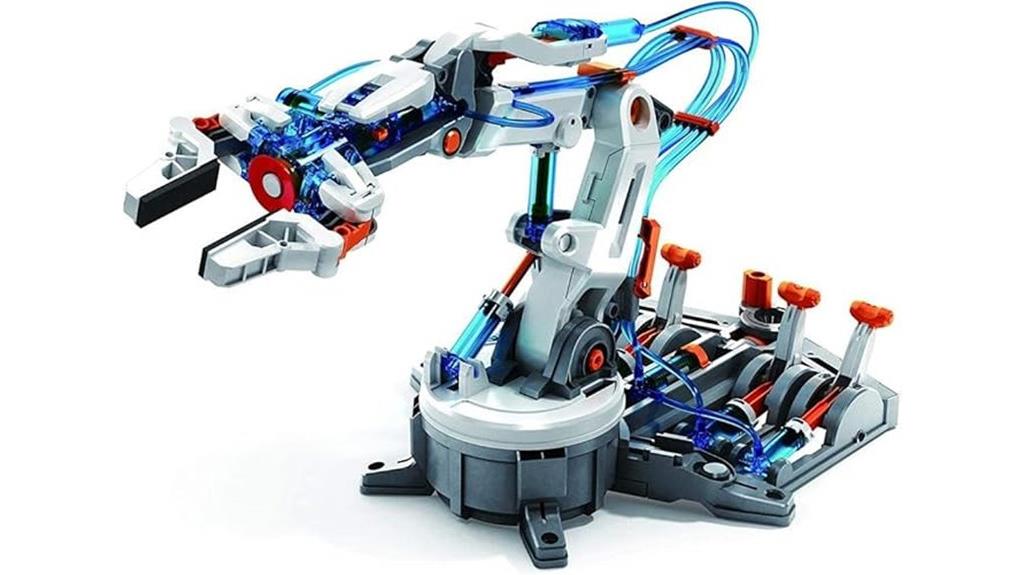
The Hydrobot Arm Kit stands out as an ideal choice for young aspiring engineers aged 12 and up who want to explore robotics and hydraulics hands-on. Powered by water, it requires no batteries, making it eco-friendly and safe. The kit features a multi-axis arm with six degrees of freedom, capable of rotating 270°, reaching over 16 inches vertically, and lifting up to 50 grams. Its precise levers and braking system allow for accurate control, while removable grippers and alternative suction attachments expand its versatility. Designed to teach mechanics, hydraulics, and engineering concepts, it’s a fun, educational way to develop problem-solving and analytical skills.
Best For: young aspiring engineers aged 12 and up interested in hands-on robotics, hydraulics, and STEM education.
Pros:
- Eco-friendly design powered by water, no batteries needed.
- Offers a realistic multi-axis robotic arm with precise control and versatility.
- Enhances STEM learning through engaging, educational activities and clear instructions.
Cons:
- Assembly may be challenging for some younger users; supervision recommended.
- Limited lifting capacity (50g), which may restrict certain experimental applications.
- Requires water, wind, or sun for power, which could limit portability or use in certain environments.
Kids First Coding & Robotics Kit by Thames & Kosmos

Designed for early learners, the Kids First Coding & Robotics Kit by Thames & Kosmos is perfect for children as young as four who are just beginning to explore STEM concepts. This unplugged kit requires no screens, instead using a manual and physical code cards to program Sammy, a fun robot shaped like a sandwich. Kids build models, solve story-based challenges, and learn coding basics like sequences, loops, and conditionals through hands-on activities. Suitable for ages four to eight with adult help, it promotes problem-solving, engineering, and computational thinking. With engaging stories and clear instructions, it makes early STEM learning accessible and enjoyable.
Best For: young children aged four to eight who are just beginning to explore STEM concepts through hands-on, unplugged activities with adult guidance.
Pros:
- Encourages early STEM learning with no screens necessary, making it accessible for young children.
- Uses engaging story-based modules and physical coding cards to promote problem-solving and creativity.
- Aligned with educational standards and designed to develop foundational coding, engineering, and computational thinking skills.
Cons:
- Requires adult assistance for children as young as four, which may limit independent use.
- Uses batteries and physical components that may need replacement or maintenance over time.
- Limited to basic coding concepts; more advanced topics require additional tools or kits.
Thames & Kosmos Architectural Engineering Science Kit
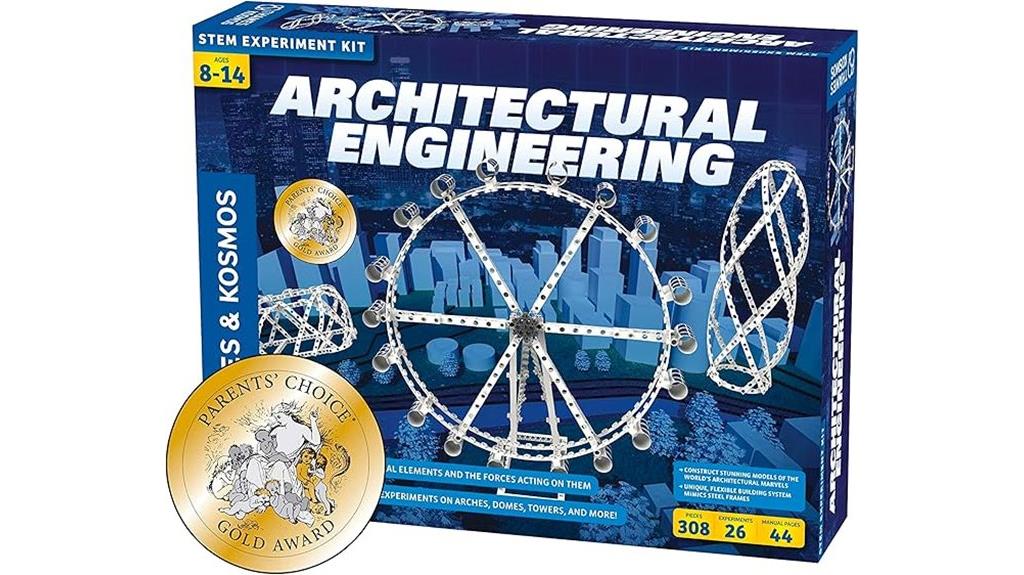
If you’re looking for a hands-on way to introduce kids to architecture and engineering, the Thames & Kosmos Architectural Engineering Science Kit is an excellent choice. It includes 26 models, from simple trusses and arches to complex structures like stadiums and skyscrapers, suitable for ages 8 and up. The kit features flexible pieces that mimic steel frames, helping kids understand modern building materials and principles. With 20 guided exercises and a detailed manual, children learn how structures are designed, built, and tested. Awarded the Parents’ Choice Gold, it sparks creativity, problem-solving, and engineering skills through engaging, real-world building projects.
Best For: young aspiring architects and engineers aged 8 and up who want a hands-on, engaging introduction to structural design and building principles.
Pros:
- Provides a comprehensive, hands-on learning experience with 26 detailed model projects.
- Promotes STEM skills, creativity, and problem-solving through real-world building challenges.
- Award-winning design with high-quality, flexible pieces that mimic modern construction materials.
Cons:
- May require adult supervision for younger children to ensure proper assembly.
- Some models might be challenging for beginners within the age range.
- The kit’s complexity might be less suitable for children seeking very simple or quick projects.
LEGO Boost Creative Toolbox 17101 Robot Building Set and Coding Kit
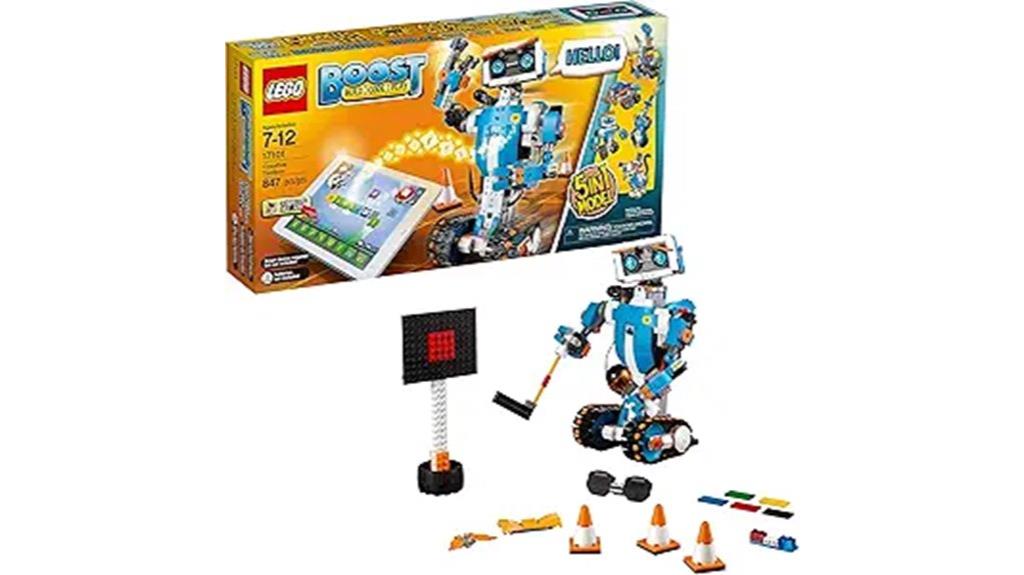
Kids aged 7-12 who are curious about robotics and coding will find the LEGO Boost Creative Toolbox 17101 to be an engaging and educational choice. This set includes 847 LEGO pieces that let kids build five different models, like Vernie the Robot, Frankie the Cat, and a guitar-playing machine. It introduces coding through an intuitive app, allowing children to program their creations to dance, play music, or interact. The models feature sensors and advanced tech, making the play experience both fun and educational. It’s perfect for fostering creativity, problem-solving, and STEM skills, all while enjoying hands-on building and programming.
Best For: children aged 7-12 who are interested in exploring robotics, coding, and STEM activities through hands-on building and programming.
Pros:
- Encourages creativity, problem-solving, and STEM skills through interactive models and coding activities
- Includes advanced sensors and technology for an engaging, realistic robotics experience
- Compatible with multiple devices and offers easy-to-use, step-by-step app instructions
Cons:
- Requires 6 AAA batteries (not included), adding to the overall cost
- The set may be complex for younger children at the lower end of the age range without adult assistance
- The app and tech features depend on device compatibility, which may vary among users
Factors to Consider When Choosing LEGO Spectrometer Projects for Kids
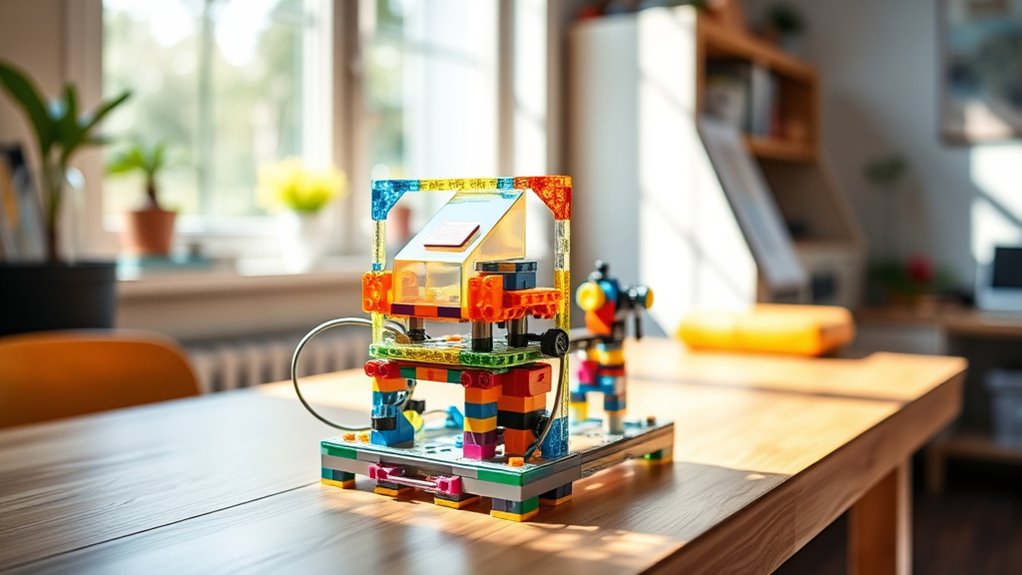
When selecting a LEGO spectrometer project for a child, I consider several key factors to guarantee it’s the right fit. I look at age appropriateness, educational value, and how complex the building process is, so it matches the child’s skills and interests. Safety, durability, and device compatibility also play essential roles in making a smart choice.
Age Appropriateness
Choosing the right LEGO spectrometer project starts with considering the child’s age to guarantee it aligns with their developmental stage. It’s important to select projects designed for children between 8 and 14 years old, matching their cognitive and motor skills. Check the recommended age range on the instructions to ascertain the project suits their current abilities. Younger kids benefit from simpler designs focusing on basic assembly and understanding, while older children can handle more complex scientific concepts. Make sure the project includes clear, illustrated instructions that match their reading level to promote independent learning or guided activities. Additionally, opt for projects with safe, age-appropriate tools and features, ensuring a fun, safe, and engaging experience suitable for their age.
Educational Content Depth
A LEGO spectrometer project with appropriate educational content can substantially enhance a child’s understanding of light and spectroscopy. I look for projects that include detailed explanations of light spectra, absorption, and emission, as these build a solid scientific foundation. It’s important that the content covers basic concepts like wavelength, frequency, and the electromagnetic spectrum, making complex ideas accessible. Interactive experiments that demonstrate real-world applications, such as identifying materials or analyzing light sources, deepen engagement and comprehension. Clear, step-by-step instructions that explain the science behind each activity ensure learners grasp the concepts effectively. Additionally, supplementary materials like quizzes or extension activities reinforce learning and help assess understanding, making the project both educational and enriching.
Building Complexity Level
Selecting the appropriate complexity level for a LEGO spectrometer project is essential to guarantee kids stay engaged and learn effectively. If the project is too simple, older children or more advanced learners may become bored, while overly complex builds can frustrate beginners, discouraging their interest. Beginners benefit from straightforward projects with fewer components and clear instructions, which help build confidence and foundational STEM skills. Intermediate and advanced projects often include intricate mechanisms, coding, or sensors, offering a richer challenge for those ready to deepen their understanding. Matching the project’s complexity to the child’s age and skill level ensures they remain motivated and avoid frustration. Ultimately, choosing the right level promotes both enjoyment and meaningful learning, laying a solid foundation for future exploration.
Compatibility With Devices
Making sure your LEGO spectrometer project works smoothly with your device starts with checking its compatibility. First, verify that the project supports your device’s operating system—whether iOS, Android, Windows, or MacOS—to guarantee the app or software runs correctly. Next, see if the project requires specific hardware features like Bluetooth, USB ports, or Wi-Fi to connect seamlessly. It’s also important to confirm the availability and compatibility of the supporting app or software with your device’s version and specifications. Additionally, check whether any advanced features, like augmented or virtual reality, are supported by your device’s hardware and software. Finally, review any device-specific instructions or requirements provided by the project to avoid issues during setup or operation.
Safety and Durability
When choosing a LEGO spectrometer project for kids, safety and durability should be top priorities. Make sure all components are made from non-toxic, BPA-free plastics that meet safety standards for children’s toys. Check that the design minimizes sharp edges and small parts to prevent choking hazards, especially for kids under age 8. Durability is also essential—select projects with LEGO pieces that can withstand repeated assembly and disassembly without cracking or breaking easily. It’s important that the instructions include clear safety guidelines, particularly for handling light sources, chemicals, or electronic components. Additionally, consider the longevity of the materials used, ensuring the project remains safe and functional over time without deterioration. Prioritizing these factors guarantees a safe, durable, and enjoyable STEM experience for young explorers.
Project Versatility
A versatile LEGO spectrometer project should easily adapt to a variety of scientific experiments, allowing kids to explore different light sources and materials. Look for projects with modular components that can be reconfigured to test various spectroscopic techniques. Adjustable parts or settings are essential to accommodate different levels of complexity, making the project suitable for beginners or more advanced learners. Compatibility with additional sensors or accessories broadens the range of experiments and deepens learning opportunities. A flexible design also enables future expansion or customization, supporting ongoing scientific investigations and creative exploration. Choosing a project with these features ensures that kids can adapt and grow their skills, making the spectrometer a valuable tool for hands-on science learning and experimentation.
Cost and Budget
Choosing a LEGO spectrometer project that fits your budget helps you get the most value without overspending. I recommend establishing a clear budget range to identify affordable options and avoid unnecessary expenses. Remember to factor in the total cost, including any additional accessories or compatible parts needed for the project. Comparing prices across different retailers and online platforms can help you find the best deals and prevent overpaying. Also, consider potential costs for replacement parts or future upgrades, especially if the project is modular or expandable. Lastly, allocate some funds for the educational benefits, ensuring the investment enhances learning and keeps your child engaged long-term. Staying mindful of these factors helps you balance cost with educational value, making the project both affordable and rewarding.
Frequently Asked Questions
What Are the Safety Precautions for Building LEGO Spectrometers?
When building LEGO spectrometers, I always make sure to work in a clean, organized space to prevent accidents. I supervise kids closely, especially when handling small parts or tools. I remind everyone to avoid sharp edges and to handle any electrical components carefully. Wearing safety glasses is a good idea if there’s a risk of debris. Most importantly, I encourage respectful use of all parts to keep everyone safe and engaged.
How Can I Customize a LEGO Spectrometer for Different Scientific Experiments?
Customizing a LEGO spectrometer is like tuning a musical instrument to match your experiment. I suggest swapping out diffraction gratings or adding filters to analyze different wavelengths. You can also modify the light source or detector for varied results. Experiment with different LEGO pieces to create attachments that hold these components securely. This flexibility helps you explore diverse scientific questions while keeping your setup fun and adaptable.
What Age Range Is Most Suitable for Beginner LEGO Spectrometer Projects?
I think the most suitable age range for beginner LEGO spectrometer projects is around 8 to 12 years old. At this stage, kids have developed enough fine motor skills and understanding of basic science concepts to build and experiment confidently. These projects are simple yet engaging, helping young learners explore light and spectra while having fun. It’s a perfect way to introduce them to scientific inquiry in an accessible, hands-on way.
How Do LEGO Spectrometers Compare to Traditional Scientific Instruments?
Think of LEGO spectrometers as a friendly scout compared to high-tech scientists’ tools. While they can’t match the precision of professional instruments, they’re fantastic for learning. I once built one with my niece, and it helped her understand light spectra through hands-on fun. They’re perfect for education, sparking curiosity, but for detailed research, traditional instruments are still essential.
Are There Any Recommended Complementary Tools or Materials for Enhanced Experiments?
Yes, I recommend adding a smartphone or tablet with a camera to capture spectra visually. You can also use diffraction gratings, LED light sources, and different colored filters to expand your experiments. These tools help enhance your understanding of light properties and spectra analysis. I find that combining these materials makes exploring science more engaging and allows you to experiment more creatively, deepening your learning experience.
Conclusion
Exploring these LEGO spectrometer projects can spark a child’s curiosity and inspire future scientists. Did you know that STEM toys boost a child’s interest in science by over 60%? By choosing the right kit, you’re opening doors to creativity and learning. Whether building robots or exploring physics, these projects make science fun and accessible. So, immerse yourself and watch your child’s passion for discovery grow with every experiment!
